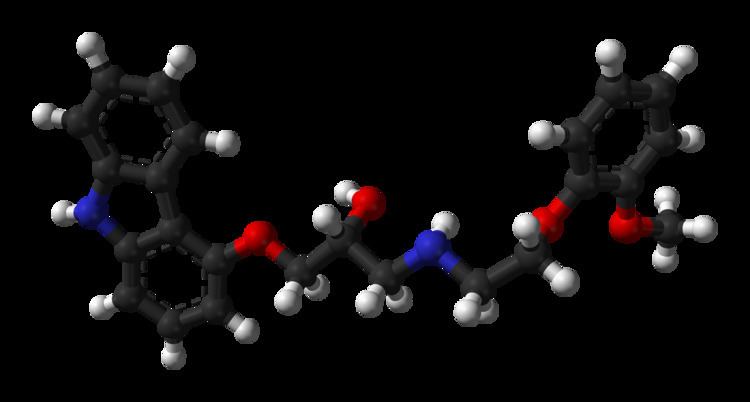Trade names Coreg MedlinePlus a697042 CAS ID 72956-09-3 | AHFS/Drugs.com Monograph Pregnancycategory C ATC code C07AG02 (WHO) Protein binding 98% | |
 | ||
Carvedilol side effects
Carvedilol, sold under the brand name Coreg among others, is a beta blocker used for treating mild to severe congestive heart failure (CHF), left ventricular dysfunction (LVD) following heart attack in people who are otherwise stable, and for treating high blood pressure.
Contents
- Carvedilol side effects
- Medical use
- Side effects
- Contraindications
- Mechanism of action
- Pharmacokinetics
- Formulations
- References
Beta blockers block the beta receptors on heart muscle and other cells, making them more relaxed and less responsive to stress hormones. Carvedilol also blocks alpha receptors, which are found on blood vessels, and relaxes the blood vessels, dilating them, which lowers blood pressure and vascular resistance.
It is a nonselective beta blocker/alpha-1 blocker and belongs to the third generation of beta blockers.
Carvedilol was discovered by Fritz Wiedemann at Boehringer Mannheim and was initially approved in the U.S. in 1995. On October 20, 2006, the FDA approved an extended-release formulation.
Medical use
Carvedilol is indicated in the management of congestive heart failure (CHF), commonly as an adjunct to angiotensin-converting-enzyme inhibitor (ACE inhibitors) and diuretics. It has been clinically shown to reduce mortality and hospitalizations in people with CHF. The mechanism behind its positive effect when used long-term in clinically stable CHF patients is not fully understood, but is thought to contribute to remodeling of the heart, improving upon its structure and function.
In addition, carvedilol is indicated in the treatment of hypertension and to reduce risk of mortality and hospitalizations in a subset of people following a heart attack. It can be used alone or with other anti-hypertensive agents.
Side effects
The most common side effects (>10% incidence) include:
Carvedilol is not recommended for people with uncontrolled bronchospastic disease (e.g. current asthma symptoms) as it can block receptors that assist in opening the airways.
Carvedilol may mask symptoms of low blood sugar.
Contraindications
According to the FDA, carvedilol should not be used in people with bronchial asthma or bronchospastic conditions. It should not be used in people with second- or third-degree AV block, sick sinus syndrome, severe bradycardia (unless a permanent pacemaker is in place), or a decompensated heart condition. People with severe hepatic impairment are also not advised to take carvedilol.
Mechanism of action
Carvedilol is both a non-selective beta adrenergic receptor blocker (β1, β2) and an alpha adrenergic receptor blocker (α1). The S(-) enantiomer accounts for the beta blocking activity whereas the S(-) and R(+) enantiomer have alpha blocking activity.
Carvedilol reversibly binds to beta adrenergic receptors on cardiac myocytes. Inhibition of these receptors prevents a response to the sympathetic nervous system, leading to decreased heart rate and contractility. This action is beneficial in heart failure patients where the sympathetic nervous system is activated as a compensatory mechanism.
Carvedilol blockade of α1 receptors causes vasodilation of blood vessels. This inhibition leads to decreased peripheral vascular resistance and an antihypertensive effect. There is no reflex tachycardia response due to carvedilol blockade of β1 receptors on the heart.
Pharmacokinetics
Carvedilol is about 25% to 35% bioavailable following oral administration due to extensive first-pass metabolism. The compound is metabolized by liver enzymes, CYP2D6 and CYP2C9 via aromatic ring oxidation and glucuronidation, then further conjugated by glucuronidation and sulfation. Compared with the parent compound, the three active metabolites exhibits only one-tenth of the vasodilating effect of the parent compound. However, the 4’hydroxyphenyl metabolite is about 13-fold more potent in ß-blockade than the parent compound.
The mean half-life of carvedilol following oral administration ranges from 7 to 10 hours. Carvedilol has two enantiomers: R(+)-carvedilol and S(-)-carvedilol. R(+)-carvedilol undergoes preferential selection for metabolism, so the mean half-life of the enantiomer is about 5 to 9 hours compared with 7 to 11 hours for the S(-)-enantiomer.
The majority of carvedilol is bound to plasma proteins (98%), mainly to albumin. Carvedilol is a basic, hydrophobic compound with a steady-state volume of distribution of 115 L. Plasma clearance ranges from 500 to 700 mL/min.
Absorption is slowed when administered with food, however, it does not show a significant difference in bioavailability. Taking carvedilol with food decreases the risk of orthostatic hypotension.
Formulations
•Tablet, Oral
•Capsule Extended Release 24 Hour, Oral
